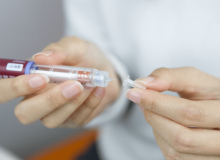Many people with diabetes who have been sick for a long time and frequently monitor their blood sugar will find that their blood sugar fluctuates twice a day. Diabetic patients often have two periods of hyperglycemia that are difficult to control in the early morning and afternoon due to the reduction or disappearance of basal insulin secretion, which are called the "dawn phenomenon" and the "dusk phenomenon" respectively. That is, the high blood sugar that occurs in diabetic patients at dawn is called the "dawn phenomenon", and the high blood sugar that occurs in the evening is called the "twilight phenomenon."
In diabetic patients, when the blood sugar level is stable from evening to night and there is no hypoglycemia reaction, the blood sugar will gradually rise from 3 a.m. to 7 a.m. to 8 a.m. and reach a peak in the morning. The early morning hyperglycemia state caused by unstable and unbalanced secretion is called the "dawn phenomenon."
The reason why this phenomenon occurs is, ultimately, due to poor blood sugar control. Dawn phenomenon generally occurs in people with type 1 diabetes, but also occurs in a few people with type 2 diabetes. These people have satisfactory blood sugar control during the day, but their blood sugar is very high every morning. People with diabetes will have their blood sugar rise around 3 a.m. and last until 8 to 9 a.m. The blood sugar is in a "high and then high" state. The emergence of the dawn phenomenon is directly related to the secretion of glucagon, adrenaline, glucocorticoids, growth hormone and insulin in the body. Growth hormone gradually rises after a deep sleep at midnight, and glucocorticoid secretion increases after 0 o'clock, reaching its peak at 4-6 o'clock in the morning. The pancreatic islet cells of people with diabetes are basically damaged and cannot secrete enough insulin to carry out normal activities. The antagonistic effect directly leads to the phenomenon of dawn hyperglycemia. If the dosage of medication was insufficient the night before, or the medication was taken too early, the "dawn phenomenon" may easily occur.
The second peak of blood sugar is between 4 and 7 o'clock in the afternoon, when blood sugar rises, which is called the "twilight phenomenon." However, there are also patients whose "twilight phenomenon" appears later, manifested in blood sugar before going to bed that is even higher than blood sugar 2 hours after a meal. Some experts believe that the twilight phenomenon is caused by the patient's improper diet and exercise.
In normal people, basal insulin secretion will increase with the increase of glucagon to ensure normal blood sugar levels. However, the insulin secretion of our diabetic patients is not enough to counteract the glucogenic effect caused by glucagon. This uncoordinated secretion of insulin and glucogenic hormones is the basic cause of the "dawn phenomenon" and "dusk phenomenon".
To deal with the "dawn phenomenon", you can change the insulin injection time. You can use intermediate or long-acting insulin during sleep and increase the dosage of insulin under the guidance of a doctor so that its effect can be maintained until after dawn.
To deal with the "twilight phenomenon", you can eat less lunch and more meals to keep blood sugar stable after meals. You can also exercise half an hour after a meal to lower blood sugar. Type 1 diabetics who have the conditions can use an insulin pump for treatment to keep their blood sugar levels in a relatively stable state throughout the day.
Of course, no matter "dawn" or "dusk", sugar lovers need to maintain a good and positive attitude and sleep. Take your blood sugar seriously.
The above information is for reference and discussion only and cannot be used as a basis for diagnosis or medical treatment. Specific medication or treatment plans should be used under the guidance of a professional doctor.

